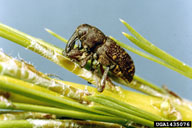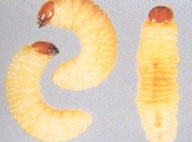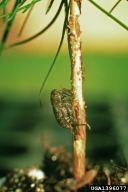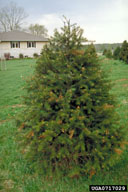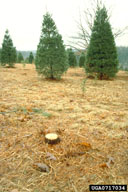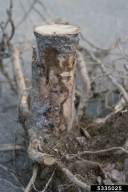Pales weevil
Hylobius pales (Herbst) (Coleoptera: Curculionidae)
Orientation to pest
The pales weevil, Hylobius pales (Herbst), is native to North America, where it is the most serious pest of young seedling pines in both cutover lands undergoing regeneration and in recently planted plantations or Christmas tree plantations where stumps have not been removed. This weevil is also the vector of Leptographium procerum the causal agent of Leptographium root disease. The species overwinters as adults beneath litter or as larvae in roots. Eggs are laid in the roots of fresh stumps, where larvae then create galleries and feed. Pupation occurs in the outer sapwood. There is usually one generation per year and adults can live up to 2 years. Adult feeding on young seedlings (up to 1 cm in diameter) is the most important type of damage because it may cause girdling and tree death. Adult feeding can also kill tips of branches. In cut over forest land, damage can be lowered by delaying replanting for 1 or 2 years to allow adults to emerge from infested stumps and leave the area. In Christmas tree plantations, damage can be lowered by delaying replanting of cut areas, treating stumps with pesticides to kill adult weevils, or maintaining stumps in a living condition to prevent breeding (as in coppice harvesting of Christmas trees).
Hosts commonly attacked
The pales weevil affects all pines (Pinus spp.) native to North America and also many exotic pines. It is also found in spruce (Picea spp.), fir (Abies spp.), juniper (Juniperus spp.), larch (Larix spp.), hemlock (Tsuga spp.), northern white cedar (Thuja occidentalis L.), and Douglas fir (Pseudotsuga menziesii [Mirbel] Franco).
Distribution
The pales weevil is found throughout eastern North America, west to the Great Plains and north to southern Canada.
Images of pales weevil
| Figure 1. Adult of the pales weevil, Hylobius pales | Figure 2. Larvae of pales weevil, removed from galleries | |
| Figure 3. Left, pale weevil larvae develop in roots of stumps left after harvest; right, bark removed from stump to show the breeding galleries of pales weevil | Figure 4. Feeding by adult pales weevils can girdle and kill seedlings (left) or branches (right), destroying forest regeneration or damaging the shape and appearance of Christmas trees | |
Important biological control agents related to this pest species
The only known specialized natural enemy of this species is the euphorine braconid parasitoid Microctonus pachylobi Muesebeck, which develops in the adult weevil.
Web links for information on pales weevil
- Fact Sheet | ForestPests.org | USDA Forest Service, Southern Region
- BugwoodWiki Article | wiki.bugwood.org
- Fact Sheet | Virginia Cooperative Extension
Articles
- Zanzot, J. W., G. Matusick, and L. G. Eckhardt. 2010. Ecology of root-feeding beetles and their associated fungi on longleaf pine in Georgia. Environmental Entomology 39: 415-423.
- Nevill, R. J. and S. A. Alexander. 1992. Transmission of Leptographium procerum to eastern white pine by Hylobius pales and Pissodes nemorensis (Coleoptera; Curculionidae). Plant Disease 76: 307-310.
- Dixon, W. N. and J. L. Foltz. 1990. Pine reproduction weevils, Hylobius pales (Herbst) and Pachylobius picivorus (Germar) (Coleoptera: Curculionidae). Entomology Circular #332, University of Gainesville, Florida.
- Lynch, A. M. 1984. The pales weevil, Hylobius pales (Herbst): a synthesis of the literature. Journal of the Georgia Entomological Society 19 (3, Suppl. 1).
- Corneil, J. A. and L. F. Wilson. 1981. How to identify and control pales weevil [Hylobius pales] in Christmas tree plantations. St. Paul, Minnesota: North Central Forest Experiment Station, USDA Forest Service, 5 pp.
